Fortifying Your Market Research with the Qualitative Survey
Fortifying Your Market Research with the Qualitative Survey
Qualitative research is critical for performing market research. Using what’s known as the qualitative survey is the most potent instrument researchers can apply to garner data for this kind of research.
It’s important to be able to distinguish between qualitative and quantitative surveys when delving into either of these main types of survey research methods. As such, this article will focus on the qualitative survey, its corresponding research method, best practices and other considerations worth being mindful of.
With these key insights, you’ll be able to get your qualitative research up in running in no time.
Defining the Qualitative Survey
This type of survey is characterized by its adherence to qualitative research, that is, it seeks to gain descriptive insights on a topic, rather than measuring it.
A qualitative survey is predicated on digging into the details behind a topic. It also seeks to find causality and motivations. This provides details around happenings, opinions, beliefs and sentiments.
In short, it helps brands understand their target market’s psyche, as opposed to measuring for prevalence and other metrics.
This kind of survey is far less structured than a quantitative survey; it also makes more use of open-ended questions. While it provides a great deal of knowledge, this survey data can be more difficult to analyze.
When to Use a Qualitative Survey in Your Research Endeavors

A qualitative survey can be used in the beginning of your market research, or as a way to complement research you’ve already begun conducting. There are specific points during your market or survey research that you can best tend to with a qualitative survey. Here are several such cases:
- Mapping out a hypothesis: A qualitative survey is an excellent way to both form a hypothesis and test it. As you begin your research process, this survey can help you find the most glaring issues and desires your target market has on their minds. These can help you form hypotheses that you can prove through quantitative research. You can also test your hypotheses with follow-up qualitative surveys.
- When numbers and scales aren’t enough: Usually, a scaled survey isn’t enough — neither is one with visual ratings (hearts, stars, etc.). A qualitative survey can benefit your study to completely flesh out the themes, sentiments and general makeup of an occurrence.
- Finding the “why” behind a phenomenon: You can administer a qualitative survey for this point in the middle of your research process. For instance, if you’ve run several quantitative surveys or even a qualitative survey, you will have gathered insightful data on the big picture of a topic. But there may be a few missing pieces, especially regarding the why behind an occurrence or firmly held belief. That’s where you would do further probing with this type of survey.
- Discovering Latent Details: Although these details may be covert, they can help crack a customer experience (CX) or employment satisfaction puzzle. Whereas quantitative surveys help unlock the number of times something occurs or if it occurs in the grand scheme of things, qualitative surveys can help bring hidden details into light. By asking qualitative questions, you can uncover a gold mine when it comes to pleasing customers, as you’ll understand them in greater depth.
- Putting together the final stages of your market research: Often conducted after gathering quantitative findings, you can use a qualitative survey to wrap up your research. There may be times in which you need more details to understand the results of a previous survey. Or there may be some key aspects that you feel you need to find to complete your research. The qualitative survey is a good closer for these needs.
How to Get Started on Formulating a Qualitative Survey
You may have several ideas on the direction you desire your qualitative research to take. When opting for a qualitative survey, there are certain tips you can stand to learn. The following presents certain key practices to take into consideration when embarking on this survey method.
- Find a strong online survey platform to execute your research. Here are a few things to look for in online survey tools.
- Discover the chief campaign of your qualitative research needs. Are you looking to improve your branding? Do you need insights on a specific industry, such as the technology industry?
- Then, find the main need for this application. Or perhaps, see if there are some missing qualitative data you would need to acquire.
- Create an overall theme for a survey, or for multiple surveys.
- Begin with one survey at a time; first, gather the target audience of the survey. You can appeal to your general target market, or to a segment of it.
- Draft your questions and get observations/commentary from other researchers or colleagues.
- Launch your survey and carefully read over your responses. Cross-reference the answers with quantitative surveys, especially if your quantitative survey is underpinned by quantitative research you’ve already begun.
- Iterate with another survey if need be.
- Analyze your responses to find motivations and find deeper insights into themes and opinions.
- Layout a plan of action for your broader campaign based on your analyses.
- Take small steps; don’t rush (unless you’re facing a crisis). Start implementing some of the changes or accommodations for your target market. Or, finish your research with a presentation of your discoveries.
Questions and Surveys to Use in a Qualitative Survey
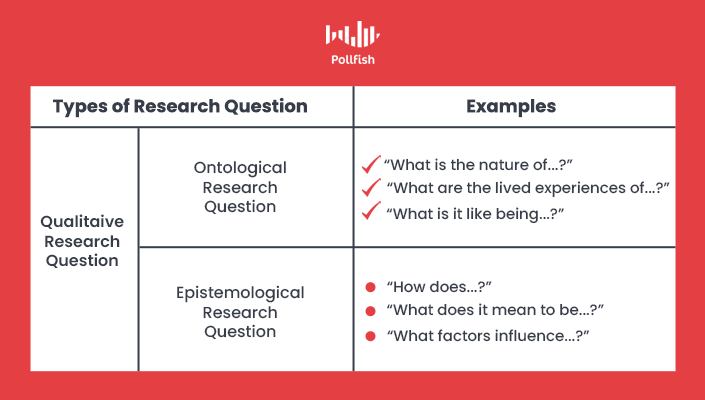
A qualitative survey can exist in a variety of formats. We’ve covered a wide variety of survey research methods and survey types themselves. Since qualitative studies can be applied across a number of survey types, you ought to know how to orient your questions around several of them.
Here are a few question examples of qualitative surveys. You can also add qualitative elements to surveys that are not specifically geared for qualitative research.
Net Promoter Score (NPS) Survey Questions:
Along with the Ultimate Question, aka the main NPS survey question, use the following to extract qualitative data. (This question typically asks respondents on a scale of 1-10, how likely they are to recommend a company to others.)
- Why is it that you’ve ranked us with this score? [open-ended]
- What do you like the most about our company? [open-ended]
- What services or products do you enjoy the most from our brand? [open-ended or multiple choice]
- What are some of the things that we can do to improve how you view our brand?
Customer Loyalty Survey Questions:
Consumer loyalty is a widely-encompassing quality that can be evaluated in a number of market research studies. This includes using the Repeat Purchase Rate and Customer Lifetime Value metrics. Additionally, the notion of customer loyalty has several of its own surveys.
- Do you consider [brand] to be high-quality? Why or why not? [multiple choice and open-ended]
- Would you return to make more purchases from us? Why or why not? [multiple choice and open-ended]
- Why have you bought [x number of times, carry forwarded from previous numerical question] from us? [open-ended]
- Why are you [either considering yourself a loyal customer or not, piped from previous yes or no question]? [open-ended]
Product Satisfaction Survey Questions:
- Which features do you find most useful from this product? [multiple choice]
- How would you rate the product’s ease of use and why? [open-ended and multiple choice]
- Have you experienced any issues with the product, if so what are they? [open-ended and multiple choice]
- How has your general experience been with our product? [open-ended]
Retrospective Survey Questions:
Although these surveys are typically used in the fields of medicine and psychology, they too can be applied to the business market research sphere. Used in retrospective studies, these surveys scrutinize events that have taken place in the past (including the distant past).
- Which aspects in your [in-store, over the phone or online] experience have contributed to the way you shop today? [open-ended and multiple choice]
- How long have you been taking part in/buying [habit, product or brand]? [multiple-choice]
- Have you used [product] in the past and how has it shaped what you currently use for your [niche] needs? [open-ended and multiple choice]
- Why have you bought/chosen from [brand/product] for [x number] of years/months? [open-ended]
Event Evaluation Survey Question Examples:
- What did you like the most about the event? [open-ended]
- What experience stuck out the most to you and why? [open-ended or multiple choice]
- What could we do to improve your experience? [open-ended]
- Is there anything else you would like to tell us about the event? [open-ended]
Expanding Your Research Needs
Although the qualitative survey can help you unearth the “why” and “how” in your research on your target market, you’ll find that much like with quantitative surveys, it too can help you uncover more on the “what.”
The difference is that this type of survey allows you to get more granular and in-depth on a subject matter, whereas quantitative surveys paint a clear picture of its measurements, metrics and other quantifiable data.
Bear in mind that in the aforementioned qualitative question/survey types examples, each survey type is not intrinsically — or solely to be used for qualitative research. In fact, it often includes a mash-up of both qualitative and quantitative aspects.
This is natural in survey research, as both of these surveys and research types work in tandem. As such, make sure to add qualitative questions every now and then to your quantitative surveys. However, if you are looking purely for qualitative research, you can also attempt to conduct an entirely qualitative survey. The online survey tool you choose to apply is your best armor.
Frequently asked questions
What is a qualitative survey?
A qualitative survey is a type of survey that is focused on gathering descriptive insights and exploring motivations or causes for certain phenomena.
How are qualitative surveys different from quantitative surveys?
Quantitative surveys are focused on collecting data that can be assigned a numerical value in order to easily measure or quantify it. Quantitative surveys tend to answer the “what or who,” while qualitative surveys focus on the “why” or “how.”
What types of surveys can include qualitative questions?
Almost any type of survey can include qualitative questions, even if the bulk of the survey contains quantitative questions. Some of the most common survey types to include qualitative questions are the Net Promoter Score (NPS) survey, customer loyalty survey, product satisfaction survey, and retrospective survey.
How can qualitative survey questions help expand your research?
If you have begun collecting data on a certain topic, but have yet to unlock the “why” or “how” behind that data, qualitative survey questions can provide the missing piece. By allowing you to dig deeper into the psyche of your respondents, you can uncover additional information or unexpected responses.
When should qualitative surveys be used?
Qualitative surveys can be used to complete existing research data in order to gain deeper insights. A qualitative survey can help you form a hypothesis, better understand your target audience, and/or figure out why something is happening.
The Complete Guide to Qualitative Market Research
The Complete Guide to Qualitative Market Research
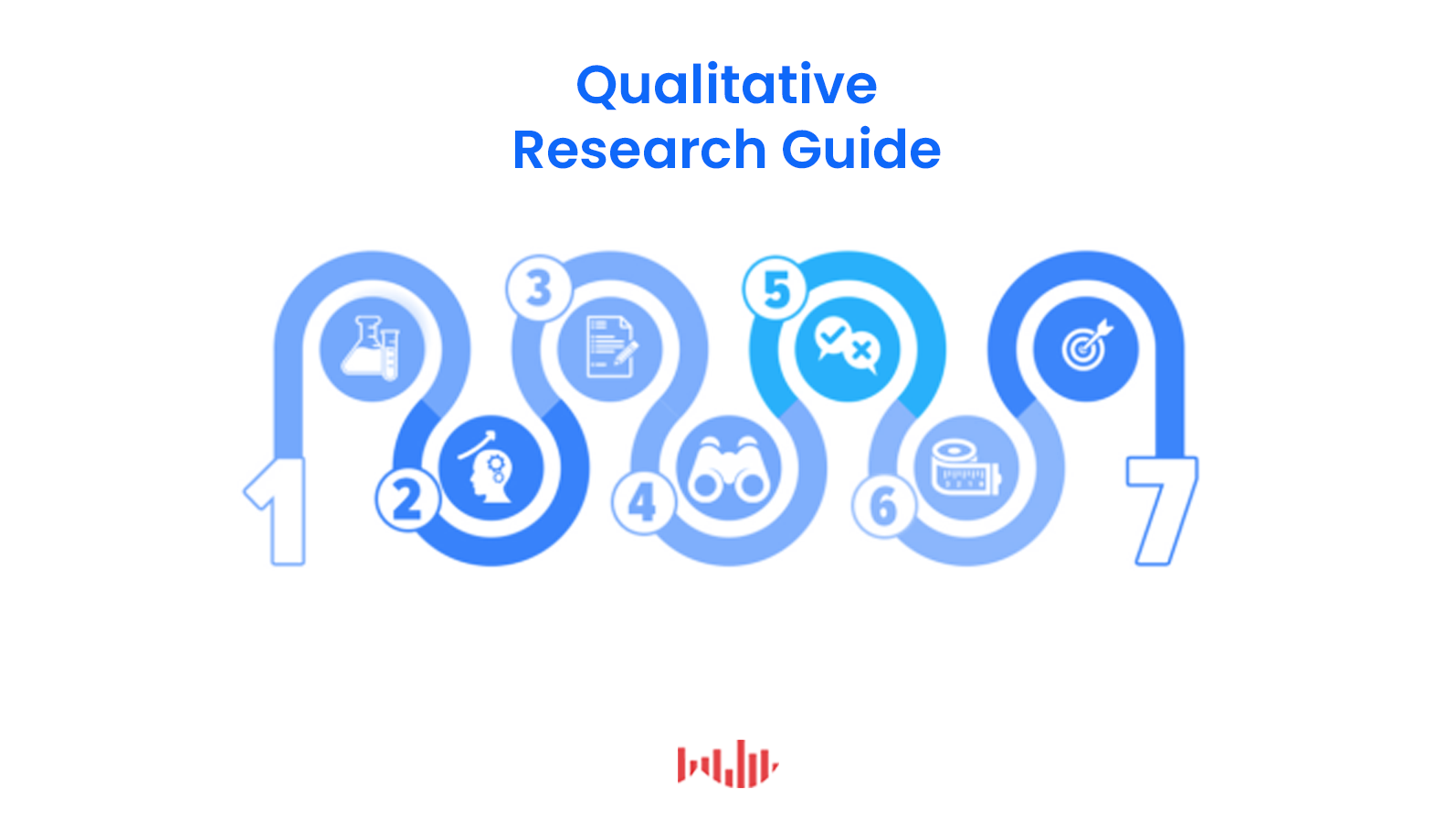 Qualitative research is one of the most prominent research methods in the ever-increasing research sphere. Running counter to quantitative research, qualitative research encompasses a distinct set of differentiating qualities (no pun intended). These attributes prove that these two methods ought not to be used interchangeably.
Qualitative research is one of the most prominent research methods in the ever-increasing research sphere. Running counter to quantitative research, qualitative research encompasses a distinct set of differentiating qualities (no pun intended). These attributes prove that these two methods ought not to be used interchangeably.
So what exactly is qualitative research? At a glance, this type of research method seeks to gather in-depth data about a phenomenon without focusing on numerical data or on quantities.
But there is much more to this kind of study method. Learn holistically about qualitative market research with this complete guide.
What Defines & Makes Up Qualitative Research?
Qualitative research is centered around experiences, ideas and opinions. As such, it does not focus on statistical or quantitative outcomes. Instead, it seeks out an in-depth understanding of an issue, occurrence or phenomenon.
Thus, this research method zeroes in on the “what” and more importantly, the “why” of a research subject. (Unlike quantitative research, which focuses on the “how much”).
Here are some of the applications of qualitative research:
Understanding an issue in greater depth
Finding the reason behind an occurrence (whether it’s desirable or undesirable)
Uncovering trends in target market opinions
Forming educated solutions to address customer/studied subject concerns
Discovering the causes of certain actions
Qualitative research generally relies on a smaller sample size in order to get a deep read of happenings, causes and motivations. This kind of research method functions through the usage of open-ended and exploratory questions.
Understanding the “why” behind an issue is then used to make decisions on how to resolve the issue or how to improve on an existing productive situation.
Qualitative data must occur in natural environments. This denotes a kind of environment in which participants discuss their opinions at length and at ease, which researchers use to gain deeper knowledge and form inferences around a topic.
Prior to the internet, this kind of research was conducted in-person, but with the advent of the internet and innovations in market research, qualitative data has been collected online. The digital space can also serve as a natural environment.
The Five Main Types of Qualitative Research
Just as with quantitative research, there is not a single approach to conducting qualitative research. On the contrary, there are five main varieties of performing qualitative research. Aside from their methodology, these sub-categories also seek different types of answers and conclusions.
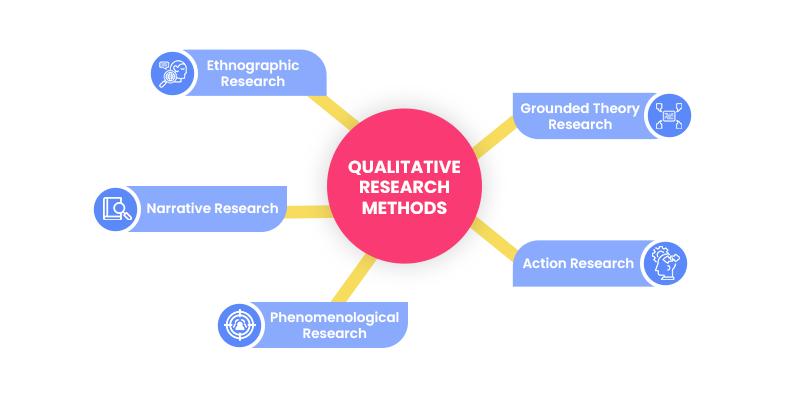
1. Narrative Research
This research is used to form a cohesive story, or narrative, by way of consolidating several events from a small group of people. It involves running in-depth interviews and reading up on documents featuring similar actions as a means of theme-searching.
The point of this is to discover how one narrative is shaped by larger contextual influences. Interviews should be conducted for weeks to months and sometimes even for years. The narrative that the researcher uncovers does not have to be presented in sequential order.
Instead, it should be projected as one with defined themes that attempt to reconcile inconsistent stories. This method can highlight the research study’s ongoing challenges and hardships, which can be used to make any improvements.
2. Ethnographic Research
The most common qualitative research method, ethnography relies on entrenching oneself in various participant environments to extract challenges, goals, themes and cultures.
As the name suggests, it involves taking an ethnographic approach to research, meaning that researchers would experience an environment themselves to draw research. Using this firsthand observation, the researcher would not need to then rely on interviews or surveys.
This approach may seem to be far-fetched where market research is concerned, but it is doable. For example, you’d like to see the effectiveness or frustration that customers face when using your product. Since you can’t follow them home, you can request videos that show them using it. Many big brands have call-outs on their websites (ex: on product pages) for their customers to send in videos of their interactions with the products.
3. Phenomenological Research
This qualitative method entails researchers having to probe a phenomenon or event by bringing lived experiences to light and then interpreting them. In order to achieve this, researchers use several methods in combination.
These include conducting surveys, interviews and utilizing secondary research such as available documents and videos on the studied phenomenon. Additionally, as in ethnographic research, phenomenological research involves visiting places to collect research.
These will help you understand how your participants view your subject of examination. In turn, you will gain insight into the participants’ motivations.
In this research type, you would conduct between 5 and 25 surveys or interviews, then peruse them for themes. Once again, you would scrutinize experiences and sentiment over numerical data.
4. Grounded Theory Research
In contrast to phenomenological research, which seeks to fully form the core of an issue, grounded theory attempts to find explanations (the why) behind an issue. To achieve this, researchers use interviews, surveys and secondary research to form a theory around the issue/occurrence.
The sample of this study tends to be on the larger side, at 20-60 participants. Data extracted from this type of research is interpreted to determine the reasoning behind, for example, heavy usage of or frustration with a product. These types of studies help a business innovate an existing product by getting into the weeds of how it’s used.
5. Action Research
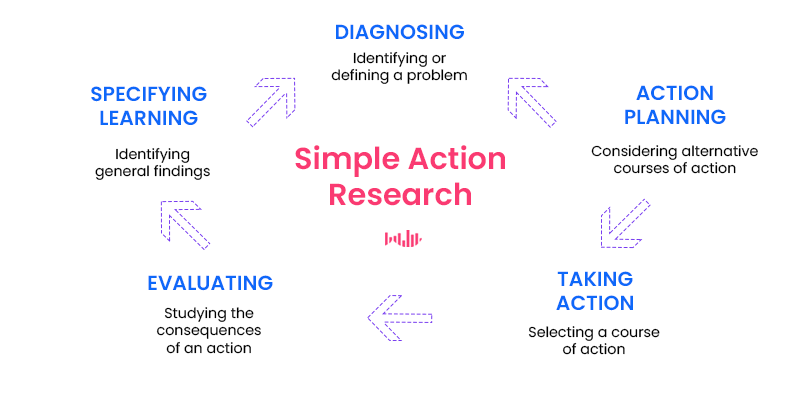
This type of research involves researchers and participants working collaboratively to bring theory to practice. Also called participatory research, collaborative inquiry, emancipatory research and action learning, this method entails the act of “learning by doing.”
This means a group of researchers come together to find and address a problem, resolve it and then study the success of their endeavors. If they underperformed or their outcomes don’t satisfy their expectations, they would then reattempt the process.
In action research, a researcher spends a considerable amount of time on collecting, analyzing, and presenting data in an ongoing, periodic process. This involves researchers coming up with their own surveys and interviews around a subject matter, then presenting their findings to one another to draw conclusions and solutions.
They would put into practice the means to improve a situation and continue measuring their success throughout the process.
Examples of Questions for Qualitative Research
When working within the capacity of any of the above research types, it’s crucial to ask the right questions. Here you’ll find the questions you can use when conducting each of the five types of qualitative research.
Bear in mind that some of these questions will appear to be similar in nature; some are even interchangeable. That is normal, as researchers may search for the same answers, but apply a different approach in their research method.
In any case, all of the below features questions that fit within the larger qualitative research framework.
Learn more about asking insightful market research questions. Here are a few examples of the questions within the five categories:
1. How do people who witnessed domestic violence understand its effects in their own relationships?
Variable: Views of domestic violence on one’s own relationships
Demographic: People in relationships, who’ve witnessed domestic violence
Qualitative Research Type: Narrative
2. What are the lived experiences of working-class Americans between the ages of 20 and 40?
Variable: Experiences and views of a working-class background
Demographic: Working-class Americans ages 20-40
Qualitative Research Type: Narrative
3. How do Asian Americans experience reaching out to address mental health concerns?
Variable: The experiences in seeking out care for mental health
Demographic: Asian Americans seeking help for mental health
Qualitative Research Type: Ethnographic
4. What do you enjoy about this product or service?
Variable: The positive experiences of using a particular product/service
Demographic: The target market of a product or service
Qualitative Research Type: Ethnographic
5. How have people who have experienced poverty changed their shopping habits when they entered the middle (or higher) class?
Variable: The changes or stagnation in shopping habits
Demographic: those who experienced poverty, but climbed the social ladder
Qualitative Research Type: Phenomenological
6. What was it like when you had a negative online shopping experience?
Variable: unpleasant shopping experiences
Demographic: a group that is most likely to shop at a particular online store
Qualitative Research Type: Phenomenological
7. What influences managers in private sectors to seek further professional advancement?
Variable: Motivation for seniority
Demographic: Managers in the private sector
Qualitative Research Type: Grounded Theory
8. How do women in third world countries set up financial independence?
Variable: Efforts at reaching financial independence
Demographic: Women in third-world countries
Qualitative Research Type: Grounded Theory
9. What impact does collaborative working have on the UX optimization efforts of a telecommunications company?
Variable: effects of collaboration on the UX of a telecommunications company
Demographic: workers in the telecommunications space
Qualitative Research Type: Action Research
10. What strategies can marketing managers use to improve the reach of millennial customers?
Variable: Strategies to improve millennial reach and their outcomes
Demographic: Marketing managers
Qualitative Research Type: Action Research
When to Use the Research and How to Analyze It
The qualitative research method has specific use cases. You ought to consider which is best for your particular business, which includes your strategy, your marketing and other facets.
The core of qualitative research is to understand a phenomenon (a problem, an inadequacy, and a slew of other occurrences) including its causes, its motivations, its goals and its solutions. Researchers do this by observing smaller portions of a population.
Researchers should use this form of research whenever you need to get the gist of a particular occurrence or event. It is particularly useful for studying how your target market experiences certain situations and how it feels about them.
There are several more specific ways that elucidate why this research style is valuable if not completely necessary. Here are some of the most crucial ways this method of research is vital:
Helps brands see the emotional connections customers have with them
Allows brands to find gaps in customer experience (CX) and user experience (UX)
Enables brands to create experiences that are more tailored to their target market
Helps businesses understand how they can improve on their product, service or CX
Finds experiences that customers had that highlight sensitive topics/language for them
Shows businesses how customers compare them to their competitors
Identifies possible solutions and innovations based on customer attitudes and experiences
To analyze qualitative research, you should first identify your subject of study and decide on the type of research you need to conduct based on the five types of research that fall under the qualitative category.
Then, brainstorm several questions that you can use to form the base of your studies. During the process make sure to jot down (either digitally or otherwise) your observations. For example, record interviews and store surveys in an organized database.
Make sure you ask open-ended questions in surveys, interviews, focus groups, et al. Aggregate secondary research such as government database documents, articles in your niche, images, videos and more.
Search for patterns or similarities within your findings. When you group them together and organize them by demographics, you can start drawing conclusions and proposing solutions.
The Benefits and Drawbacks of Qualitative Research
Qualitative research can be extraordinarily beneficial. But as with other aspects of research and beyond, it too comes with a set of drawbacks. As a business owner, marketer or market researcher, you should know both the pros and cons. Here are some notable ones:
Benefits
More intimate understanding of context and causation: besides understanding “what” in a granular way, you also learn the “why” and “how” of a particular situation.
Understanding key experiences: Open-ended questions lead to unique answers, exposing things numerical-based surveys can’t answer.
A foundation of deep insights: The design of the study is made to understand how customers relate to particular occurrences, events, ideas and products.
Context-driven: Finding insights on motivation and past behaviors allows researchers to understand what their target market needs and what it tries to avoid.
No need to find and create the correct measuring units: Open-ended questions don’t require a scale, a number range or any other measuring tools — one less thing to worry about.
Smaller sample size: Smaller sample sizes allow researchers to study responses more thoroughly to form more accurate hypotheses and conclusions.
Inspirational: The responses received can also help researchers form new studies.
Flexible and detail-oriented: Since questions aren’t based on scales and other units, you can ask more creative and in-depth questions. Questions focus on details and subtleties for robust insights.
Drawbacks
Relies on researcher experience: It relies on the researchers’ experience; not all are familiar with industry topics.
Not statistically representative: Only collects perspective-based research; does not provide statistical representation. Only comparisons, not measurements can be executed.
Difficult to make copies of data. Individual perspectives make it hard to replicate findings, making it it more difficult to form conclusions.
More likely to have researcher bias: Both conscious or subconscious of the researcher can affect the data. The conclusions they draw can thus be influenced by their bias. (This can be avoided by using controls in data collection.
The Final Word
Market research is a wide-spanning undertaking. It has a wide swath of aspects, practices and applications. As such, researchers should know its main categories and qualitative research is one such category of significance.
As opposed to quantitative research, which has four methods, qualitative research has five — not all of which will be of use to your particular market research needs. In any case, this type of research involves imbuing as much context and particularities around a phenomenon as possible.
As such, researchers should create questions more specific to the aforementioned examples of this article. That is because those are more encompassing, generalized questions that researchers can attempt to answer after conducting all of their research and parsing of the findings.
But prior to that, researchers should ask several related questions around a particular topic and tailor those questions as best as possible to the target audience.
Frequently asked questions
What is qualitative research?
Qualitative research is a type of research that is conducted to gain deep or unexpected insights rather than focusing on numeral or quantitative data.
Why is qualitative research conducted?
Qualitative research is conducted to find the “why” of the research subject, rather than the “what’ of that subject. For example, qualitative research might be conducted to understand an issue more deeply, to understand why something is happening, or to learn how to address a target market’s concerns.
What is narrative research?
Narrative research is a type of research that is used to create an in-depth story about a phenomenon or event. It is conducted by interviewing a small group of people who were directly involved in the event.
How is ethnographic research conducted?
When conducting ethnographic research, the researchers use firsthand observations of an environment to more deeply understand the goals, challenges, or opinions of the target audience.
What is action research?
Action research is a type of qualitative research in which researchers and participants collaborate to better understand a phenomenon. Together the group works to find and solve the problem by gathering information on an ongoing and evolving basis.
Survey Research Methods: A Deep Dive
Survey Research Methods: A Deep Dive

Although survey research methods are just one tactic under the enveloping market research field of study, they too are administered in a number of ways.
That is because much like market research, there is no single or universal technique when it comes to survey research. Instead, there are various survey research methods, those that only pertain to the survey aspect of market research.
Survey research methods include different sets of classifications, from types of surveys, to data organization and more. It is key to become familiar with all of them to determine which is most suitable for your market research needs.
This article will navigate all the nuances that pertain to survey research methods.
Surveys for Quantitative vs. Qualitative Research
Market research relies on both primary and secondary research; surveys fall under the former and have several classifications. The first major one conveys the duality within survey research methods: that of quantitative and qualitative research.
Quantitative research surveys:
Quantitative research involves gathering quantitative, or numerical data. Surveys amass this data by asking questions that quantify attitudes, opinions, feelings and behaviors. The point of this kind of survey research method is to form generalizations.
Quantitative research surveys therefore use a larger sample size in order to crunch numbers on different issues and variables. This survey research method is highly dependent on using and creating mathematical and statistical data.
These surveys use this data to identify patterns in a target market, find averages, make predictions and test relationships.
Essentially, this survey research method uses respondents to understand the “what” and “how much” of a studied subject.
Qualitative research surveys:
Qualitative research zeroes in on experiences, ideas and opinions, instead of focusing on statistical or quantitative results. Instead, this survey research method seeks to holistically interpret an issue, occurrence or phenomenon.
As such, qualitative research seeks to perceive an issue in more depth, find the cause of an occurrence, create inferences, find solutions to problems and uncover trends.
This research method is centered around the “what” and even more so, the “why” of a research subject.
Unlike quantitative research, qualitative research uses a smaller sample size for a deeper understanding of causes, motivations and sentiment.
This kind of survey research method uses open-ended and exploratory questions in natural environments, in which respondents freely discuss their opinions to help researchers identify the “why” behind an issue.
Understanding the “why” is then used to make decisions on how to resolve the issue or how to improve on an existing productive situation.
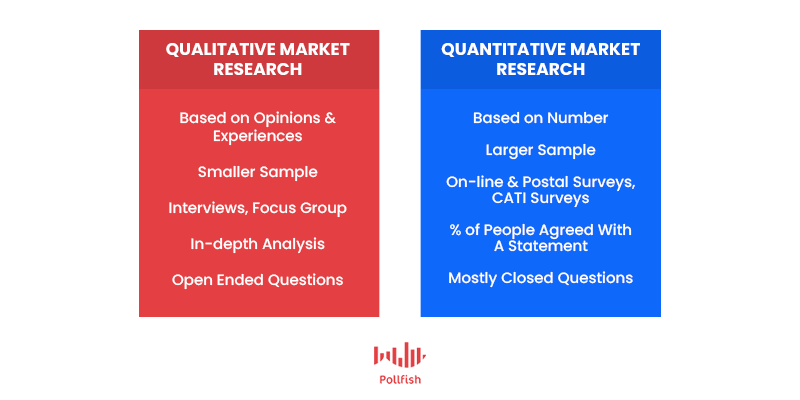
Survey Panels Vs Random Sampling
The second main classification of survey research methods is categorized via the sampling pool. There are two main types of sampling pools, i.e., the type of respondents that take part in a survey.
Market Research Panel:
A market research panel is a pre-recruited group of survey respondents who have agreed to take part in online surveys. This method is most commonly employed by market research panel companies, which require the panelists to share personal information about themselves.
This includes the information you’d find at the screener section of a survey tool such as demographics, but can also include behavioral data. The panel can be used for more than one survey; this way is convenient for market researchers who require long-term survey campaigns such as longitudinal surveys.
Random Sampling Pool:
A random sampling pool is a group of survey respondents who have not been recruited to take part in a survey. Instead, this method involves, as the name suggests, a random group of participants. They take a survey once they reach a publisher’s website or app, which is triggered by an online survey tool. As such, they take a survey due to their being real-time users on a site or app in which the survey has been launched.
Any business can take this automated approach, which does not require seeking out participants manually, as a market research panel would. Although the pool of respondents has been gathered randomly, the qualifying participants are not random.
This is because the survey software used to launch this survey includes screening questions and demographic requirements that respondents must meet to take the survey. As such, researchers still get the exact kind of participants they seek to survey. This survey research method includes probability and non-probability sampling.
Survey Research Methods Based on Campaign Type & Macro Applications
Survey research methods can be further divided based on the type of macro application (or discipline) you need the data for. They can also be categorized into different campaign types, which can fall under the macro applications, or exist as their own application.
You should understand these purposes before you choose the proper survey type for your research needs. Here are the major campaigns and applications to base your survey method on:
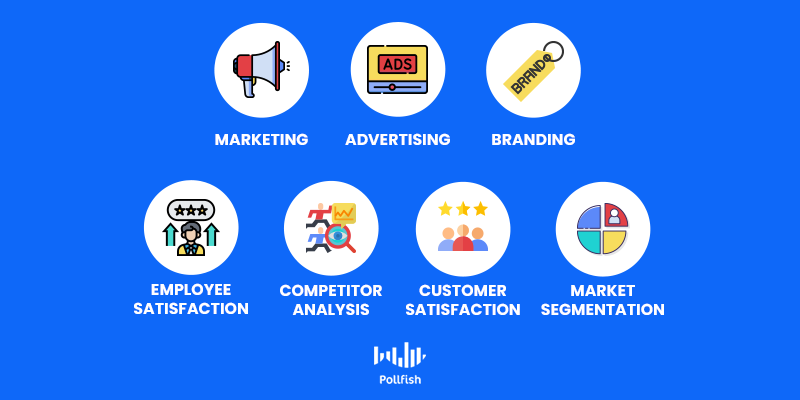
- Marketing: A broad term that includes a wide variety of processes to raise awareness and demand in your company, promote it and understand your target market.
- Advertising: One of the key practices in marketing, advertising refers to communication using overtly sponsored messages to promote or sell a product or service.
- Branding: The development of a brand’s reputation and image, along with increasing the recognition of your company.
- Market Segmentation: Facilitates targeting those most likely to be satisfied customers of your company or content. It involves splitting your target market up into smaller groups of people with similar characteristics.
- Competitor Analysis: It is the process of identifying and assessing your competitors based on their strategies to unearth their strengths and weaknesses relative to your brand.
- Employee Satisfaction: The degree to which employees are content and fulfilled with their jobs, including their schedule, work environment and banter with fellow employees.
- Customer Satisfaction: The measurement of how happy customers are with a company's products, services, experiences and interactions.
Types of Surveys
Finally, we arrive at the types of surveys, the most granular aspect of survey market research methods, that is, unless you delve further by looking into survey questions.
These surveys are classified as belonging to either quantitative or qualitative methods, along with their best application type. As for the latter classification, you ought to know that these surveys are not necessarily limited to these applications.
Rather, they are most apt for the named applications and campaigns, but due to the versatile nature of surveys, the following can be used in other applications, including those not mentioned in this article.
- Cross-sectional surveys: Gather data to make inferences about a population at some point in time.
- Used to provide snapshots of the populations they survey.
- Drawn from a few specific variables to narrow down a unique and smaller population.
- Method: Quantitative surveys
- Best used for: advertising, market segmentation, employee satisfaction, customer satisfaction, branding
- Longitudinal Surveys: Study variables over longer periods of time. (Weeks to decades)
- Require more dedication from respondents and researchers, including time and money. In this regard, a larger pool of participants is used and studied for much longer.
- Like cross-sectional surveys, these are also observational and study the exact sample pool for the length of the study.
- Method: Primarily qualitative, but can be quantitative
- Best used for: marketing, competitor analysis, market segmentation
- Retrospective Surveys: Merge aspects of both cross-sectional and longitudinal survey methods.
- Observe changes that occur over a longer period of time, but are facilitated just once.
- Thus, responders discuss occurrences, attitudes and feelings from the past.
- Method: Qualitative and quantitative surveys
- Best used for: Marketing, branding, competitor analysis
Going Beyond Survey Research Methods
Understanding the various survey research methods are crucial to forming the most fitting market research campaign for your brand. However, it doesn’t end here. With innovations in the market research field, other survey methods and sub-methods are going to emerge.
Moreover, after you’ve found the best survey research method(s) for your company, you’ll need to conduct the proper survey data analysis.
As such, you’ll need to analyze your surveys, and this can be done in a number of formats. Some are going to be more visual than others.
After all, conducting surveys is one thing, but understanding the surveys is the centerpiece of any research campaign.
Frequently asked questions
What is a quantitative research survey?
A quantitative research survey is one in which all responses can be assigned a numerical value so that results can be easily analyzed. They are used to quantify thoughts, feelings, and behaviors in order to make generalizations about the target market.
What is a qualitative research survey?
A qualitative research survey is used to gain a deeper understanding of the ideas, opinions, or experiences of a group of people. This type of survey uses open-ended questions that allow respondents to discuss their opinions freely.
What is a market research panel?
A market research panel is a group of individuals who have been selected to participate in a series of surveys over a specific period of time.
What is a random sampling pool?
A random sampling pool is a group of individuals who have been selected at random to participate in a survey. In an online survey tool, a sample pool is derived via automation.
What is a longitudinal survey?
A longitudinal survey is one that studies a group of individuals over a period of time, which can range from weeks to decades.




